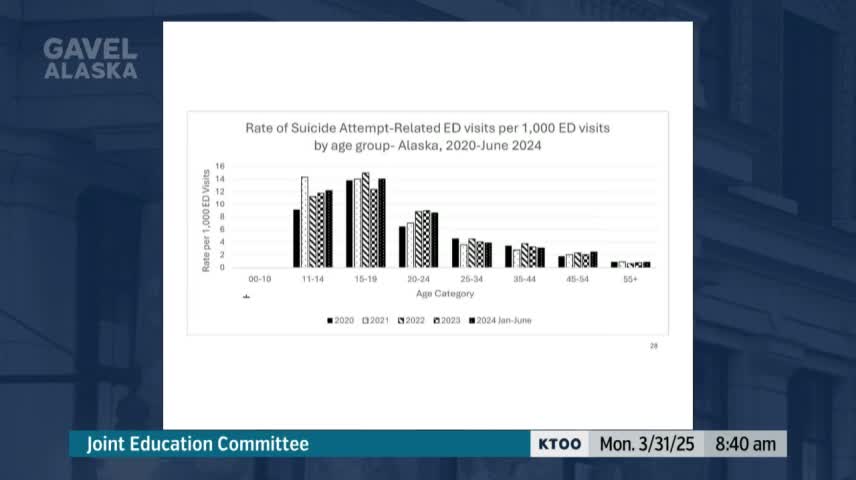Principals urge more counselors, social-emotional supports as youth mental-health indicators rise
March 31, 2025 | 2025 Legislature Alaska, Alaska
This article was created by AI summarizing key points discussed. AI makes mistakes, so for full details and context, please refer to the video of the full meeting. Please report any errors so we can fix them. Report an error »

Juneau, Alaska — School leaders described rising student mental-health needs, limited counselor capacity and school-safety measures at a joint House–Senate education committee on March 31, and urged lawmakers to fund more counseling and social-emotional supports.
“Kids in 11, 14, and 15 to 19 age… Alaska is one of the leaders in the nation in teen suicides,” said Rick Dormer, principal of Ketchikan High School and president of the Alaska Association of Secondary School Principals. He told the committee that local surveys at Ketchikan High showed 37 percent of students reported prolonged anxiety and 41 percent reported feeling so sad or hopeless that they stopped usual activities.
Dormer said those indicators reduce students’ ability to learn and that staffing shortages make it harder for districts to meet mental-health needs. He noted federal grant support in Ketchikan — a SAMHSA grant that funds a social worker in the high school — but said the city’s staffing level is unusual. “We have one social worker and that is not typical,” he said.
Dormer and other witnesses also described school-safety investments such as secured vestibules, cameras and emergency apps for teachers, noting those measures are costly. He emphasized the role of stable adult–student relationships in preventing crises: “In every school tragedy, other students knew it was happening ahead of time,” he said, urging retention of long-term staff to maintain those relationships.
Why it matters: Panelists tied mental-health and safety capacity to student learning and attendance, and said counselor ratios are far from recommended targets. Dormer cited the American School Counselor Association recommendation of 250 students per counselor and a national average of about 376 students per counselor; many Alaska schools have no counselor at all.
Ending: Presenters asked lawmakers to consider funding priorities that preserve counselors, social workers and the consistent staffing that school leaders said is central to safety and learning.
“Kids in 11, 14, and 15 to 19 age… Alaska is one of the leaders in the nation in teen suicides,” said Rick Dormer, principal of Ketchikan High School and president of the Alaska Association of Secondary School Principals. He told the committee that local surveys at Ketchikan High showed 37 percent of students reported prolonged anxiety and 41 percent reported feeling so sad or hopeless that they stopped usual activities.
Dormer said those indicators reduce students’ ability to learn and that staffing shortages make it harder for districts to meet mental-health needs. He noted federal grant support in Ketchikan — a SAMHSA grant that funds a social worker in the high school — but said the city’s staffing level is unusual. “We have one social worker and that is not typical,” he said.
Dormer and other witnesses also described school-safety investments such as secured vestibules, cameras and emergency apps for teachers, noting those measures are costly. He emphasized the role of stable adult–student relationships in preventing crises: “In every school tragedy, other students knew it was happening ahead of time,” he said, urging retention of long-term staff to maintain those relationships.
Why it matters: Panelists tied mental-health and safety capacity to student learning and attendance, and said counselor ratios are far from recommended targets. Dormer cited the American School Counselor Association recommendation of 250 students per counselor and a national average of about 376 students per counselor; many Alaska schools have no counselor at all.
Ending: Presenters asked lawmakers to consider funding priorities that preserve counselors, social workers and the consistent staffing that school leaders said is central to safety and learning.
View full meeting
This article is based on a recent meeting—watch the full video and explore the complete transcript for deeper insights into the discussion.
View full meeting
